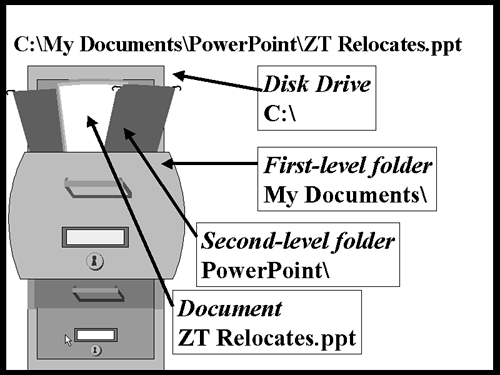A Few Words on How a PC Stores Presentations
| The best way to visualize the physical and logical storage of files is to correlate computer concepts with real-world objects, which makes Windows file management much easier to understand. The Windows interface uses disk drives , folders, subfolders , and documents for file management. A disk drive is analogous to an office filing cabinet. Like a filing cabinet, a disk drive is used to store documents that can contain presentations, spreadsheets, or databases. Each disk drive has a unique name . Typically, you access drives by referring to a corresponding letter, such as A, B, C, D, and so on. Each letter represents a distinct container ”a separate filing cabinet ”that's used to store information in your computer. Usually, the A: or B: drive is reserved for removable media, such as floppy disks. The C: drive letter designates your computer's hard drive. Other letters commonly represent additional drives ”the D: drive can be assigned to the CD-ROM drive, and any additional letter in the alphabet is probably a remote networked drive. You can understand the folder and subfolder components by expanding the filing cabinet analogy. A filing cabinet has drawers with green hanging file folders in them; these folders might contain smaller manila folders used to store paper documents in an organized fashion. The folder and subfolder concepts correspond to the green hanging folders and manila folders, respectively. As in the real world, you can store document files in either folders or subfolders. In Figure 23.1, the document path C:\My Documents\PowerPoint\ZT Relocates.ppt has been broken down to correlate it with real-world objects. Figure 23.1. A computer document can be compared to objects in a filing cabinet. |
EAN: 2147483647
Pages: 474
